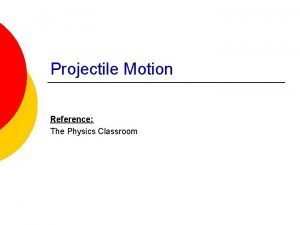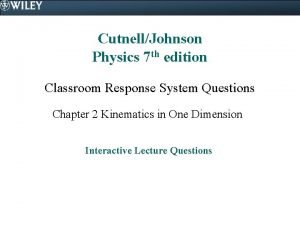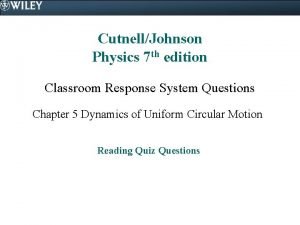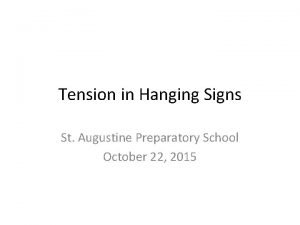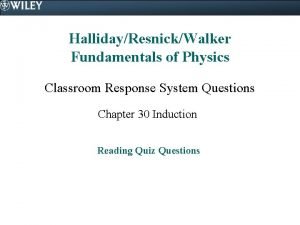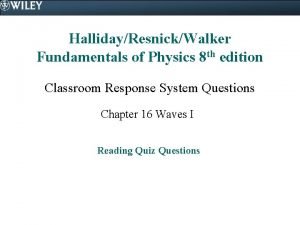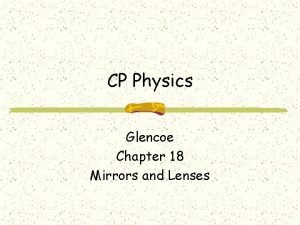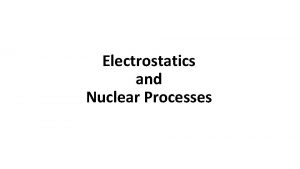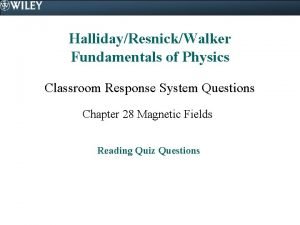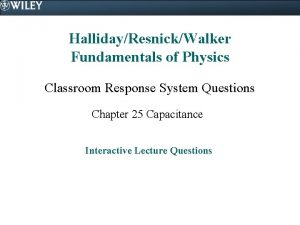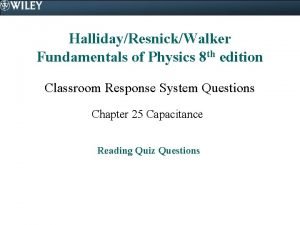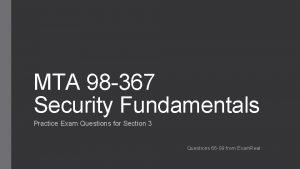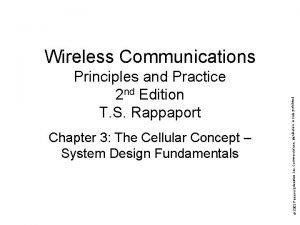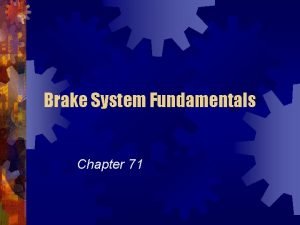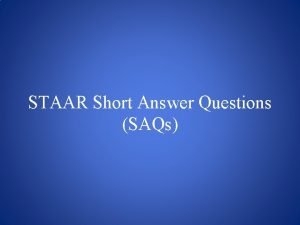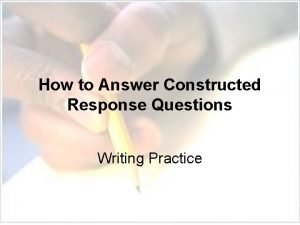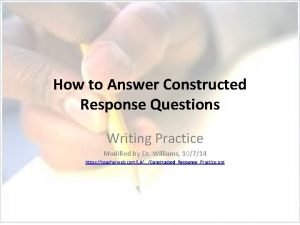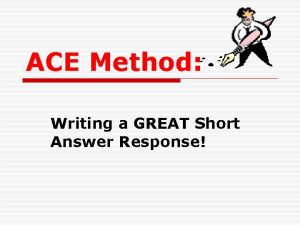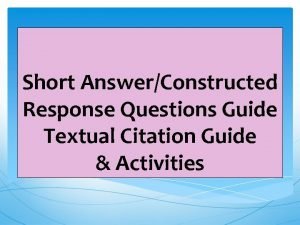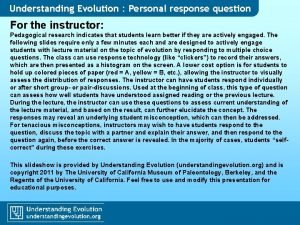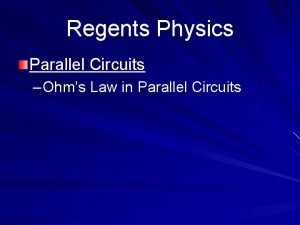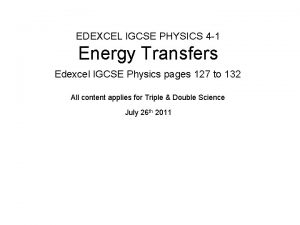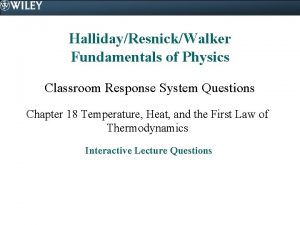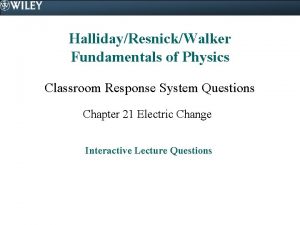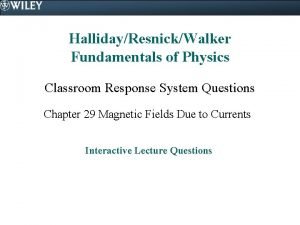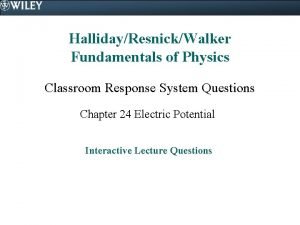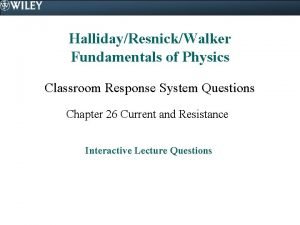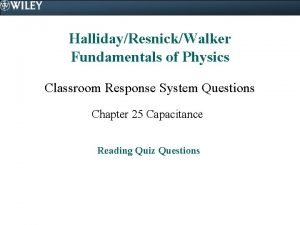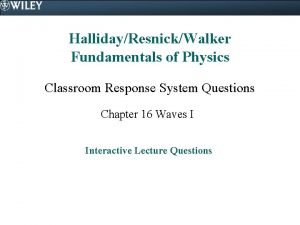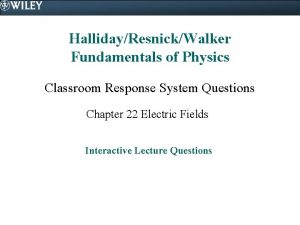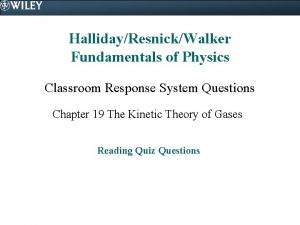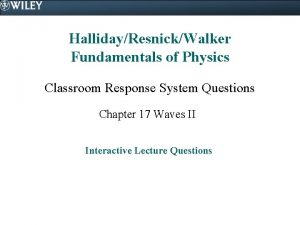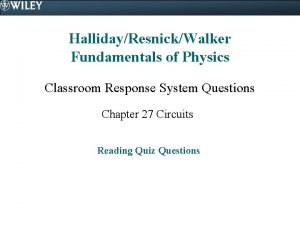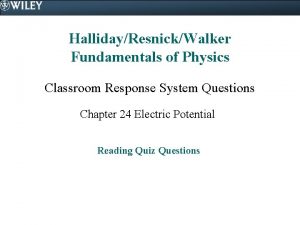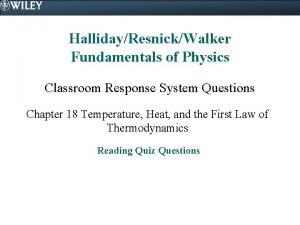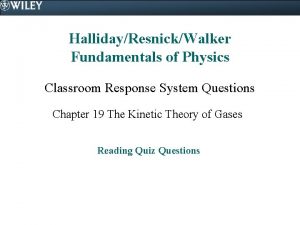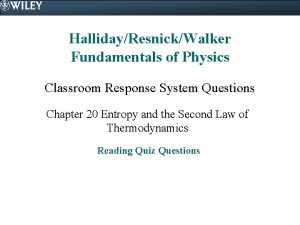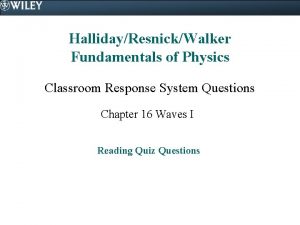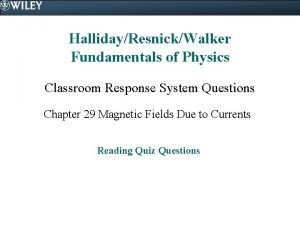HallidayResnickWalker Fundamentals of Physics Classroom Response System Questions







































- Slides: 39

Halliday/Resnick/Walker Fundamentals of Physics Classroom Response System Questions Chapter 28 Magnetic Fields Interactive Lecture Questions

28. 2. 1. Consider the two rectangular areas shown with a point P located at the midpoint between the two areas. The rectangular area on the left contains a bar magnet with the south pole near point P. The rectangle on the right is initially empty. How will the magnetic field at P change, if at all, when a second bar magnet is placed on the right rectangle with its south pole near point P? a) The direction of the magnetic field will not change, but its magnitude will decrease. b) The direction of the magnetic field will not change, but its magnitude will increase. c) The magnetic field at P will be zero tesla. d) The direction of the magnetic field will change and its magnitude will increase. e) The direction of the magnetic field will change and its magnitude will decrease.

28. 2. 1. Consider the two rectangular areas shown with a point P located at the midpoint between the two areas. The rectangular area on the left contains a bar magnet with the south pole near point P. The rectangle on the right is initially empty. How will the magnetic field at P change, if at all, when a second bar magnet is placed on the right rectangle with its south pole near point P? a) The direction of the magnetic field will not change, but its magnitude will decrease. b) The direction of the magnetic field will not change, but its magnitude will increase. c) The magnetic field at P will be zero tesla. d) The direction of the magnetic field will change and its magnitude will increase. e) The direction of the magnetic field will change and its magnitude will decrease.

28. 2. 2. Consider the two rectangular areas shown with a point P located at the midpoint between the two areas. The rectangular area on the left contains a bar magnet with the south pole near point P. The rectangle on the right is initially empty. How will the magnetic field at P change, if at all, when a second bar magnet is placed on the right rectangle with its north pole near point P? a) The direction of the magnetic field will not change, but its magnitude will decrease. b) The direction of the magnetic field will not change, but its magnitude will increase. c) The magnetic field at P will be zero tesla. d) The direction of the magnetic field will change and its magnitude will increase. e) The direction of the magnetic field will change and its magnitude will decrease.

28. 2. 2. Consider the two rectangular areas shown with a point P located at the midpoint between the two areas. The rectangular area on the left contains a bar magnet with the south pole near point P. The rectangle on the right is initially empty. How will the magnetic field at P change, if at all, when a second bar magnet is placed on the right rectangle with its north pole near point P? a) The direction of the magnetic field will not change, but its magnitude will decrease. b) The direction of the magnetic field will not change, but its magnitude will increase. c) The magnetic field at P will be zero tesla. d) The direction of the magnetic field will change and its magnitude will increase. e) The direction of the magnetic field will change and its magnitude will decrease.

28. 2. 3. What is the direction of the magnetic field at the point P, directly below a point at the center of the magnet? The numbered arrows represent various directions. Direction “ 1” is to the right, “ 2” to the left, “ 3” is upward, “ 4” is downward, and “ 5” is toward you. a) 1 b) 2 c) 3 d) 4 e) 5

28. 2. 3. What is the direction of the magnetic field at the point P, directly below a point at the center of the magnet? The numbered arrows represent various directions. Direction “ 1” is to the right, “ 2” to the left, “ 3” is upward, “ 4” is downward, and “ 5” is toward you. a) 1 b) 2 c) 3 d) 4 e) 5

28. 2. 4. Two rods are resting on a table. Although they appear to be identical, one is a permanent magnet and the other is made from soft iron and is not permanently magnetized. Which one of the following methods is most likely to reveal which rod is the magnet and which is the soft iron? a) Take one of the rods and touch it to each end of the other rod. b) Use a magnetic monopole to find the end of one of the rods that repels it. c) Move a compass along each rod to see if the compass needle behaves as it should in a magnetic field. d) There is no way to tell the difference between the two rods.

28. 2. 4. Two rods are resting on a table. Although they appear to be identical, one is a permanent magnet and the other is made from soft iron and is not permanently magnetized. Which one of the following methods is most likely to reveal which rod is the magnet and which is the soft iron? a) Take one of the rods and touch it to each end of the other rod. b) Use a magnetic monopole to find the end of one of the rods that repels it. c) Move a compass along each rod to see if the compass needle behaves as it should in a magnetic field. d) There is no way to tell the difference between the two rods.

28. 3. 1. A negatively-charged particle travels parallel to magnetic field lines within a region of space. Which one of the following statements concerning the force exerted on the particle is true? a) The force is directed perpendicular to the magnetic field. b) The force is perpendicular to the direction in which the particle is moving. c) The force slows the particle. d) The force accelerates the particle. e) The force has a magnitude of zero newtons.

28. 3. 1. A negatively-charged particle travels parallel to magnetic field lines within a region of space. Which one of the following statements concerning the force exerted on the particle is true? a) The force is directed perpendicular to the magnetic field. b) The force is perpendicular to the direction in which the particle is moving. c) The force slows the particle. d) The force accelerates the particle. e) The force has a magnitude of zero newtons.

28. 3. 2. A positively-charged particle is stationary in a constant magnetic field within a region of space. Which one of the following statements concerning the particle is true? a) The particle will not move. b) The particle will accelerate in the direction perpendicular to the field. c) The particle will accelerate in the direction parallel to the field. d) The particle will accelerate in the direction opposite to the field. e) The particle will move with constant velocity in the direction of the field.

28. 3. 2. A positively-charged particle is stationary in a constant magnetic field within a region of space. Which one of the following statements concerning the particle is true? a) The particle will not move. b) The particle will accelerate in the direction perpendicular to the field. c) The particle will accelerate in the direction parallel to the field. d) The particle will accelerate in the direction opposite to the field. e) The particle will move with constant velocity in the direction of the field.

28. 3. 3. Which one of the following statements concerning the magnetic force on a charged particle in a magnetic field is true? a) The magnitude of the force is largest when the particle is not moving. b) The force is zero if the particle moves perpendicular to the field. c) The magnitude of the force is largest when the particle moves parallel to the direction of the magnetic field. d) The force depends on the component of the particle's velocity that is perpendicular to the field. e) The force acts in the direction of motion for a positively charged particle.

28. 3. 3. Which one of the following statements concerning the magnetic force on a charged particle in a magnetic field is true? a) The magnitude of the force is largest when the particle is not moving. b) The force is zero if the particle moves perpendicular to the field. c) The magnitude of the force is largest when the particle moves parallel to the direction of the magnetic field. d) The force depends on the component of the particle's velocity that is perpendicular to the field. e) The force acts in the direction of motion for a positively charged particle.

28. 3. 4. An electron traveling due east in a region that contains only a magnetic field experiences a vertically downward force, toward the surface of the earth. What is the direction of the magnetic field? a) upward, away from the earth b) downward, toward the earth c) due north d) due west e) due south

28. 3. 4. An electron traveling due east in a region that contains only a magnetic field experiences a vertically downward force, toward the surface of the earth. What is the direction of the magnetic field? a) upward, away from the earth b) downward, toward the earth c) due north d) due west e) due south

28. 3. 5. A charged particle is moving through a constant magnetic field. Does the magnetic field do work on the charged particle? a) yes, because the force is acting as the particle is moving through some distance b) no, because the magnetic force is always perpendicular to the velocity of the particle c) no, because the magnetic field is a vector and work is a scalar quantity d) no, because the magnetic field is conservative e) no, because the magnetic force is a velocity-dependent force

28. 3. 5. A charged particle is moving through a constant magnetic field. Does the magnetic field do work on the charged particle? a) yes, because the force is acting as the particle is moving through some distance b) no, because the magnetic force is always perpendicular to the velocity of the particle c) no, because the magnetic field is a vector and work is a scalar quantity d) no, because the magnetic field is conservative e) no, because the magnetic force is a velocity-dependent force

28. 4. 1. An electron is traveling due south in a region of space at a constant speed. What can you conclude from this situation regarding the presence any electric and/or magnetic fields? a) The electric field must be zero, but the magnetic field might be non-zero in the region. b) The magnetic field must be zero, but the electric field might be non-zero in the region. c) Both the electric and magnetic field might be non-zero, but they are perpendicular to each other in the region. d) Both the electric and magnetic field might be non-zero, but they point in opposite directions in the region. e) Both the electric and magnetic field must be zero in the region.

28. 4. 1. An electron is traveling due south in a region of space at a constant speed. What can you conclude from this situation regarding the presence any electric and/or magnetic fields? a) The electric field must be zero, but the magnetic field might be non-zero in the region. b) The magnetic field must be zero, but the electric field might be non-zero in the region. c) Both the electric and magnetic field might be non-zero, but they are perpendicular to each other in the region. d) Both the electric and magnetic field might be non-zero, but they point in opposite directions in the region. e) Both the electric and magnetic field must be zero in the region.

28. 5. 1. Two metal bars, A and B, are identical in all ways, except that bar B has twice the width of A. The bars are parallel to each other, but far apart from each other, in a uniform magnetic field and carry the same amount of current in a direction perpendicular to the field. How does the Hall voltage of bar B compare to that of bar A? a) The Hall voltage for bar B will be four times greater than that of bar A. b) The Hall voltage for bar B will be two times greater than that of bar A. c) The Hall voltage for bar B will be the same as that of bar A. d) The Hall voltage for bar B will be one-half that of bar A. e) The Hall voltage for bar B will be one-fourth that of bar A.

28. 5. 1. Two metal bars, A and B, are identical in all ways, except that bar B has twice the width of A. The bars are parallel to each other, but far apart from each other, in a uniform magnetic field and carry the same amount of current in a direction perpendicular to the field. How does the Hall voltage of bar B compare to that of bar A? a) The Hall voltage for bar B will be four times greater than that of bar A. b) The Hall voltage for bar B will be two times greater than that of bar A. c) The Hall voltage for bar B will be the same as that of bar A. d) The Hall voltage for bar B will be one-half that of bar A. e) The Hall voltage for bar B will be one-fourth that of bar A.

28. 6. 1. An alpha particle (a helium nucleus which has a net positive charge) is moving due east when it enters a magnetic field that is directed due north. Which one of the following statements best describes the motion of the alpha particle after entering the magnetic field? a) The particle decelerates while traveling along a straight line until it stops. b) The particle continues at a constant speed, but its direction changes as it follows a circular path. c) The particle continues at a constant speed, but its direction changes as it follows a parabolic path. d) The particle slows and changes direction to accelerate to move due north. e) The particle slows and changes direction to accelerate to move directly upward.

28. 6. 1. An alpha particle (a helium nucleus which has a net positive charge) is moving due east when it enters a magnetic field that is directed due north. Which one of the following statements best describes the motion of the alpha particle after entering the magnetic field? a) The particle decelerates while traveling along a straight line until it stops. b) The particle continues at a constant speed, but its direction changes as it follows a circular path. c) The particle continues at a constant speed, but its direction changes as it follows a parabolic path. d) The particle slows and changes direction to accelerate to move due north. e) The particle slows and changes direction to accelerate to move directly upward.

28. 7. 1. Ernest O. Lawrence, of the University of California, Berkeley, invented the cyclotron in 1929. A more modern version was completed in 1961 at the Lawrence-Livermore Laboratory that has a radius of 88 inches. What is the frequency of circular motion at the “ 88 -incher” if protons are circulating in a magnetic field of 0. 48 T? a) 1. 4 × 106 Hz b) 4. 5 × 106 Hz c) 7. 3 × 106 Hz d) 3. 6 × 105 Hz e) 9. 7 × 104 Hz

28. 7. 1. Ernest O. Lawrence, of the University of California, Berkeley, invented the cyclotron in 1929. A more modern version was completed in 1961 at the Lawrence-Livermore Laboratory that has a radius of 88 inches. What is the frequency of circular motion at the “ 88 -incher” if protons are circulating in a magnetic field of 0. 48 T? a) 1. 4 × 106 Hz b) 4. 5 × 106 Hz c) 7. 3 × 106 Hz d) 3. 6 × 105 Hz e) 9. 7 × 104 Hz

28. 7. 2. Two positively-charged particles are moving in circles within a uniform magnetic field. Particle A has a radius that is one-half that of particle B. Which one of the following statements concerning these particles is true? a) Both the velocity of particle A and its frequency are larger than those of particle B. b) Both the velocity of particle A and its frequency are smaller than those of particle B. c) The velocity of particle A is larger than that of particle B, but its frequency is smaller than that of particle B. d) The velocity of particle A is smaller than that of particle B, but its frequency is larger than that of particle B. e) The velocity of particle A is smaller than that of particle B, but they both have the same frequency.

28. 7. 2. Two positively-charged particles are moving in circles within a uniform magnetic field. Particle A has a radius that is one-half that of particle B. Which one of the following statements concerning these particles is true? a) Both the velocity of particle A and its frequency are larger than those of particle B. b) Both the velocity of particle A and its frequency are smaller than those of particle B. c) The velocity of particle A is larger than that of particle B, but its frequency is smaller than that of particle B. d) The velocity of particle A is smaller than that of particle B, but its frequency is larger than that of particle B. e) The velocity of particle A is smaller than that of particle B, but they both have the same frequency.

28. 8. 1. Three long, straight, identical wires are inserted one at a time into a magnetic field directed due east. Wire A carries a current of 2 A in the direction of 45 south of east. Wire B carries a current of 8 A, due north. Wire C carries a current of 10 A, due west. Rank the wires in terms of the magnitude of the magnetic force on each wire, with the largest force listed first and the smallest force listed last. a) A > B > C b) B > A > C c) C > B > A d) A > C > B e) B > C > A

28. 8. 1. Three long, straight, identical wires are inserted one at a time into a magnetic field directed due east. Wire A carries a current of 2 A in the direction of 45 south of east. Wire B carries a current of 8 A, due north. Wire C carries a current of 10 A, due west. Rank the wires in terms of the magnitude of the magnetic force on each wire, with the largest force listed first and the smallest force listed last. a) A > B > C b) B > A > C c) C > B > A d) A > C > B e) B > C > A

28. 8. 2. A portion of a loop of wire passes between the poles of a magnet as shown. We are viewing the circuit from above. When the switch is closed and a current passes through the circuit, what is the movement, if any, of the wire between the poles of the magnet? a) The wire moves toward the north pole of the magnet. b) The wire moves toward the south pole of the magnet. c) The wire moves upward (toward us). d) The wire moves downward (away from us). e) The wire doesn’t move.

28. 8. 2. A portion of a loop of wire passes between the poles of a magnet as shown. We are viewing the circuit from above. When the switch is closed and a current passes through the circuit, what is the movement, if any, of the wire between the poles of the magnet? a) The wire moves toward the north pole of the magnet. b) The wire moves toward the south pole of the magnet. c) The wire moves upward (toward us). d) The wire moves downward (away from us). e) The wire doesn’t move.

28. 8. 3. Small charged disks are inserted into a larger, insulating disk. A compass is placed near the larger disk and points due north as shown. The larger disk is then rotated uniformly counterclockwise (as viewed from above). What, if anything, will happen? a) The north end of the compass will move toward the large disk as it rotates. b) The north end of the compass will move away from the large disk as it rotates. c) The compass will not be affected by the motion of the large disk. d) The north end of the compass will oscillate toward and away from the large disk as it rotates.

28. 8. 3. Small charged disks are inserted into a larger, insulating disk. A compass is placed near the larger disk and points due north as shown. The larger disk is then rotated uniformly counterclockwise (as viewed from above). What, if anything, will happen? a) The north end of the compass will move toward the large disk as it rotates. b) The north end of the compass will move away from the large disk as it rotates. c) The compass will not be affected by the motion of the large disk. d) The north end of the compass will oscillate toward and away from the large disk as it rotates.

28. 9. 1. A circular loop of wire is placed in a magnetic field such that the plane of the loop is perpendicular to the magnetic field. The loop is then connected to a battery and a current then flows through the loop. Which one of the following statements concerning this situation is true? a) The magnetic force exerts a net torque on the loop. b) The magnetic force exerts a net force on the loop. c) The magnetic force exerts both a net force and a net torque on the loop. d) The magnetic field has no affect on the loop.

28. 9. 1. A circular loop of wire is placed in a magnetic field such that the plane of the loop is perpendicular to the magnetic field. The loop is then connected to a battery and a current then flows through the loop. Which one of the following statements concerning this situation is true? a) The magnetic force exerts a net torque on the loop. b) The magnetic force exerts a net force on the loop. c) The magnetic force exerts both a net force and a net torque on the loop. d) The magnetic field has no affect on the loop.

28. 10. 1. Consider the relationships between the directions of the torque acting on a magnetic dipole in a magnetic field, the magnetic field, and the magnetic dipole moment. Which one of the following statements regarding these directions is true? a) The torque is parallel to both the magnetic field and the dipole moment. b) The torque is perpendicular to the magnetic field, but parallel to the dipole moment. c) The torque is parallel to the magnetic field, but perpendicular to the dipole moment. d) The torque is perpendicular to both the magnetic field and the dipole moment.

28. 10. 1. Consider the relationships between the directions of the torque acting on a magnetic dipole in a magnetic field, the magnetic field, and the magnetic dipole moment. Which one of the following statements regarding these directions is true? a) The torque is parallel to both the magnetic field and the dipole moment. b) The torque is perpendicular to the magnetic field, but parallel to the dipole moment. c) The torque is parallel to the magnetic field, but perpendicular to the dipole moment. d) The torque is perpendicular to both the magnetic field and the dipole moment.
 2know classroom response system
2know classroom response system Smart classroom vs traditional classroom
Smart classroom vs traditional classroom Natural and forced response
Natural and forced response What is natural response
What is natural response A subsequent
A subsequent Supposing a snowmobile is equipped with a flare
Supposing a snowmobile is equipped with a flare Physics classroom
Physics classroom Centripetal acceleration physics classroom
Centripetal acceleration physics classroom The sign below hangs outside the physics classroom
The sign below hangs outside the physics classroom Physics classroom
Physics classroom Circular functions
Circular functions Physics classroom lenses and mirrors
Physics classroom lenses and mirrors Physics classroom electrostatics
Physics classroom electrostatics Gauss law physics classroom
Gauss law physics classroom Physics classroom magnetic field
Physics classroom magnetic field Capacitance physics classroom
Capacitance physics classroom Physics classroom kinetic energy
Physics classroom kinetic energy Farad is equivalent to
Farad is equivalent to Mta security fundamentals exam questions and answers
Mta security fundamentals exam questions and answers Why does it happen
Why does it happen University physics with modern physics fifteenth edition
University physics with modern physics fifteenth edition Ib physics hl ia examples
Ib physics hl ia examples System design fundamentals
System design fundamentals Brake system fundamentals
Brake system fundamentals Identify each type of neuronal pool
Identify each type of neuronal pool Fundamentals of information systems chapter 1
Fundamentals of information systems chapter 1 Sensory input and motor output
Sensory input and motor output Nerve cell processes
Nerve cell processes Chapter 23 computer system fundamentals
Chapter 23 computer system fundamentals Short response questions
Short response questions Selected response questions
Selected response questions Answer for this question
Answer for this question Higher biology essay questions
Higher biology essay questions How to write a constructed response question
How to write a constructed response question Crq questions
Crq questions Ace format writing example
Ace format writing example Ttqa
Ttqa Personal response questions
Personal response questions Physics regents circuit questions
Physics regents circuit questions Sankey diagram for one bounce of a ball answers
Sankey diagram for one bounce of a ball answers





